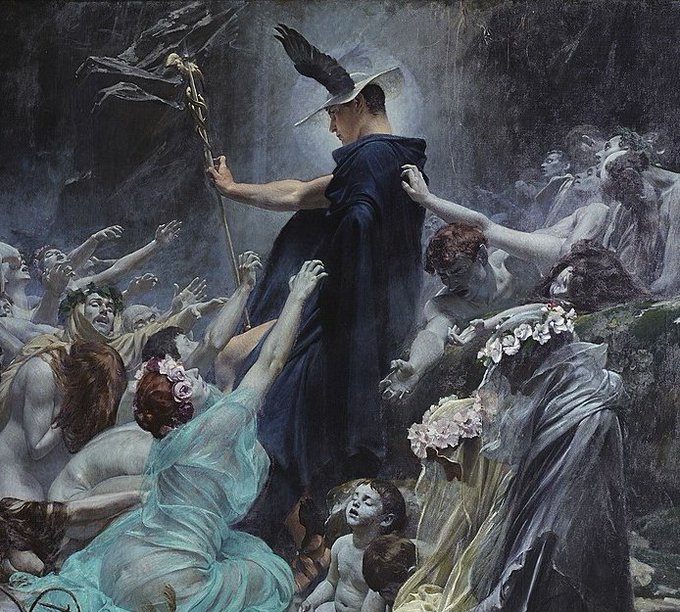FolkloreThursのTwitterイラスト検索結果。 3,976 件中 21ページ目
🌿Warding off evil #spirits is the mugwort, a #plant said to protect against #pandemics too, so wear some around your neck...
https://t.co/NlOK2rQmlq
#FolkloreThursday #Romania #Im4Ro
🌿Love in #Romania is brought by handsome Dragobete with his ebony hair and eyes as green as spring leaves. He's the one teaching us how to love. As a reward Virgin Mary turned him into a #plant, Navalnic, hart’s-tongue fern.
https://t.co/g2SMJHyH1q
#FolkloreThursday #Im4Ro
#FolkloreThursday Akelarre is the Basque term meaning Witches' Sabbath.Akerra means male goat and Larre means field.The Spanish Inquisition accused people of worshipping Satan. In Basque Country there are places with names related to sabbat meetings https://t.co/FReAwsN8FH
🎨Goya
#FolkloreThursday
In Wirral myth Thor’s Stone is named after the Norse god Thor by C10 Viking settlers, who used it as a pagan altar. Thor is said to have tossed the rocks there in anger. Nowadays Morris dancers meet there to enact their rites on Mayday mornings.
🎨ArthurRackham
In the 1670s, Peter Banks, a Newcastle-based cunning man, sold year-long ‘leases’ for 20 shillings. These paper charms prevented the holder from dying in that time. They were popular with sailors who bought new ones every year #FolkloreThursday [Image by Jan Porcellis]
Cumbrian folklore for #folklorethursday
Renwick 1733, a Cockatrice took up residence in the ruined church.
A local man, John Tallantine killed the creature using rowan tree branch, although some believe it can still be seen flying around the church at night. #folklore #cumbria
If you need a daily dose of #folklore, I recommend these hashtags:
#MythologyMonday #FairyTaleTuesday #WyrdWednesday #FolkloreThursday #FaustianFriday #SuperstitionSat #SwampSunday
You may also like:
#JapaneseFolklore #yokai #ukiyoe
1/4
Shipwrights tried to affect the vessel's luck by using ash or rowan as part of the boat, building a gold coin into the framework and a silver coin under the mast and tying a red ribbon around the first nail to guard against accidents #FolkloreThursday [Image by Joseph Vernet]
🖤SPECIAL INVITATION🖤
Seated in Enugu’s wealthy suburbs, there is an unfinished house.
Some nights, strange lights can be seen from the road.
At the stroke of midnight on the 15th, you’re invited to unfold this mystery.
Do you accept? 🔮🕸
#FolkloreThursday
Past healers could be charged not because they harmed, but because they helped. Handing out herbs & trinkets unsanctioned by the prevalent god was considered the work of demons even if the tinctures or charms seemed to cure & save people. #FolkloreThursday
🎨Raphael Kirchner
Because they are cold-blooded, #mermaids don't mind the cold. #ArthurWardle, "The Lure of the North," 1912.
#PoetsCornerALW #FolkloreThursday
When the Pontcysyllte Aqueduct (k/as Llangollen Canal) was being constructed in 1795, the navies who worked on it, believed that mixing ox blood into the lime mortar would strengthen the structure, making it resilient. Well its still standing as strong as ever
#FolkloreThursday
Indigenous American agriculture techniques weren't just efficient work, they were environmentally conscious too: planting squash, beans, and corn together, a method called and often mythologized as the "Three Sisters," made work easier and replenished the soil. #FolkloreThursday
LIKE TASKS An ancient ninth-century poem, written by an Irish monk about his curiously clever #cat for #FolkloreThursday theme of work #academicswithcats
I and Pangur Ban my cat,
'Tis a like task we are at:
Hunting mice is his delight,
Hunting words I sit all night.
Carpenters in Wales said that they often heard the tolaeth or death-sound before they were asked to make a coffin. They would hear the of sawing wood, banging of nails or turning of screws as a ghastly echo of coffin-making in portent of the coming task. #FolkloreThursday
In Greek mythology, weaving was often the work of women. One of the most famous tales was of Penelope, who used weaving to keep her suitors at bay while her husband Odysseus was away. She told them she would not choose one to marry until she had finished...
#FolkloreThursday
1/2
The fable of "The Crow and the Pitcher" has a very thirsty crow unable to reach the water inside a pitcher.
Thanks to his ingenuity, he drops pebbles inside the pitcher to make the water raise, a proof to his cunning and hard work.
#FolkloreThursday #Fable #Work
The Tailor of Gloucester by @beatrixpotter was based on a true incident.
A tailor named Pritchard, making a suit for the new mayor, returned to his shop to find the suit finished save for one buttonhole. He encouraged the belief that it was fairywork. #FolkloreThursday
#Bees symbolise wealth attained through hard work. They belong to Hera, Mother Goddess of the #moon, & are therefore linked to the sign of Cancer, also known for its love of hard work. #Honey is the ambrosia of the Goddess, & symbolises richness & abundance. #FolkloreThursday
Norwegian fishermen used to believe that one of the greatest dangers associated with working at sea was Draugen, a sea monster thought to be the ghost of a drowned fisherman. If they heard eerie screaming at sea, Draugen was nearby and someone would drown.
#FolkloreThursday
















































